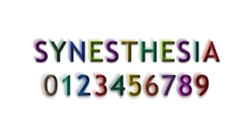
Grapheme-color synesthesia
Encyclopedia

Synesthesia
Synesthesia , from the ancient Greek , "together," and , "sensation," is a neurologically based condition in which stimulation of one sensory or cognitive pathway leads to automatic, involuntary experiences in a second sensory or cognitive pathway...
in which an individual's perception of numbers and letters is associated with the experience of colors. Like all forms of synesthesia, grapheme → color
Color
Color or colour is the visual perceptual property corresponding in humans to the categories called red, green, blue and others. Color derives from the spectrum of light interacting in the eye with the spectral sensitivities of the light receptors...
synesthesia is involuntary, consistent, and memorable. Grapheme → color synesthesia is one of the most common forms of synesthesia, and because of the extensive knowledge of the visual system
Visual system
The visual system is the part of the central nervous system which enables organisms to process visual detail, as well as enabling several non-image forming photoresponse functions. It interprets information from visible light to build a representation of the surrounding world...
, one of the most studied.
While it is extremely unlikely that any two synesthetes will report the same colors for all letters and numbers, studies of large numbers of synesthetes find that there are some commonalities across letters (e.g., "A" is likely to be red). Early studies argued that grapheme → color synesthesia was not due to associative learning, such as from playing with colored refrigerator magnets. However, one recent study has documented a case of synesthesia in which synesthetic associations could be traced back to colored refrigerator magnets. Despite the existence of this individual case, the majority of synesthetic associations do not seem to be driven by learning of this sort. Rather, it seems that more frequent letters are paired with more frequent colors, and some meaning-based rules, such as ‘b’ being blue, drive most synesthetic associations.
Experiences and reports
Synesthetes often report that they were unaware their experiences were unusual until they realized other people did not have them, while others report feeling as if they had been keeping a secret their entire lives. Many synesthetes can vividly remember when they first noticed their synesthetic experiences, or when they first learned that such experiences were unusual. Writer and synesthete Patricia Lynne DuffyPatricia Lynne Duffy
Patricia Lynne Duffy is an instructor in the UN Language and Communications Programme. She has an M.A. from Teachers College, Columbia University...
remembers one early experience:
As does filmmaker Stephanie Morgenstern
Stephanie Morgenstern
Stephanie Grace Morgenstern is a Swiss-Canadian actress, filmmaker, and screenwriter for television and film. Born in Geneva, Switzerland and raised in Montreal, Quebec, Morgenstern began her acting career when she was 15. She has worked extensively on stage, film, and television in both English...
:
On the other hand, many synesthetes never realize that their experiences are in any way unusual or exceptional. For example, the Nobel prize
Nobel Prize
The Nobel Prizes are annual international awards bestowed by Scandinavian committees in recognition of cultural and scientific advances. The will of the Swedish chemist Alfred Nobel, the inventor of dynamite, established the prizes in 1895...
winning physicist
Physicist
A physicist is a scientist who studies or practices physics. Physicists study a wide range of physical phenomena in many branches of physics spanning all length scales: from sub-atomic particles of which all ordinary matter is made to the behavior of the material Universe as a whole...
, Richard Feynman
Richard Feynman
Richard Phillips Feynman was an American physicist known for his work in the path integral formulation of quantum mechanics, the theory of quantum electrodynamics and the physics of the superfluidity of supercooled liquid helium, as well as in particle physics...
reports:
While synesthetes sometimes report seeing colors projected in space, they do not confuse their synesthetic colors with real colors in the external world. Rather, they report that they are simultaneously aware of the external color and also the internal, synesthetic color:
Finally, synesthetes are quite precise in the color mappings that they experience, which can lead them to make quite detailed comparisons of their colors:
Further research
Individuals with grapheme → color synesthesia rarely claim that their sensations are problematic or unwanted. In some cases, individuals report useful effects, such as aid in memory or spelling of difficult words.These experiences have led to the development of technologies intended to improve the retention and memory of graphemes by individuals without synesthesia. Computers, for instance, could use "artificial synesthesia" to color words and numbers to improve usability. A somewhat related example of "computer-aided synesthesia" is using letter coloring in a web browser to prevent IDN homograph attack
IDN homograph attack
The internationalized domain name homograph attack is a way a malicious party may deceive computer users about what remote system they are communicating with, by exploiting the fact that many different characters look alike,...
s. (Someone with synesthesia can sometimes distinguish between barely different looking characters in a similar way.)

